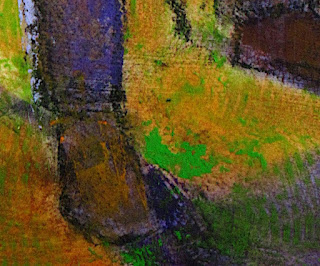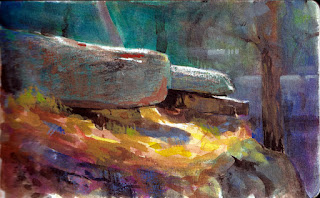 |
| 5x8 gouache sketch, Backlit Oak in the Canyon |
I'm amazed at how often the word “gouache” pops up in the art blogs I read. It seems everyone's rediscovering this old medium. Old? Yes, it's been in use for over 600 years. More recently, back in the early part of the 20th century, it was popular among illustrators as well as artists in the animation field. Although some artists, notably N.C. Wyeth, used oil paint for illustrations, gouache was more popular because it was “quick'n'dirty.” It dried quickly, allowing the artist to meet aggressive deadlines, and it dried to a velvety matte finish, eliminating any problem with glare when photographing the work for reproduction. That's the “quick” part. Now here's the “dirty” part. Many of the pigments used in “designer's gouache,” as it was called then, faded upon exposure to light. Because illustrations and animation cels were discarded soon after being photographed, nobody cared if the pigments were fugitive. Those works weren't meant to be hung on the wall or bequeathed to the next generation.
Today, most modern gouache colors will last the test of time. Some won't, however. It's important to check a color's lightfastness rating. Even so, I leave my gouache sketches where I make them—in a hardbound watercolor journal that, closed, protects them from light. Were I to frame these sketches, I would make sure to mount them under UV-proof glass such as Tru Vue.
Because gouache is an opaque, fast-drying medium, you can layer, scumble and correct. (The working properties of gouache are so similar to pastel that the two mediums are often used together.) But because it can be re-wet easily, I make sure these earlier passages are completely dry before painting over them, and I don't use much water when I do so. Here in the high desert of New Mexico, gouache dries very quickly, so I don't have to wait long.
Here are some thoughts on painting gouache en plein air:
- Use pans of gouache rather than tubes. It's easier to reactivate when dry than tubed paint. A dried blob of tube gouache is nearly impossible to re-wet because it forms a thick shell when exposed to dry air; you'll ruin your brush trying to poke a hole in it. (If you insist on tubes, you can use a Sta-Wet palette or a spray bottle to mist the paint to prevent this. But that's just more stuff to take to the field.)
- Block in the sketch first with thin washes of gouache to establish regions of warm and cool colors. Although gouache is considered an opaque medium, these nearly-transparent washes can mimic the beautiful glow one can achieve with watercolor. For example, if I want to paint an illusion of warm sunshine on a cliff, I use a thin wash of yellow ochre over what will be the sunny parts. When I later pop in the darker, cooler shadows, these sunny notes create a powerful glow.
- If you're trying to create a highlight, avoid painting it with pure white, as this will look too cold. And don't try to paint it with a light tint of a color, as this will look too grey. Instead, put down pure white where you want the highlight and then, once that mark is dry, apply a transparent wash of color on top of it. It will be cleaner and brighter than any mixed tint. It's like applying a transparent wash to white paper. (Think “watercolor” again.)
With that in mind, here are sketches (all 5x8, except for one 5x16) from my most recent expeditions into the canyon behind my studio. As it is getting hot and more humid now, thunderstorms are building up most afternoons. This will kill the brilliant “sun on rocks” motif I've been painting. I may have to go out earlier in the day before the clouds build—or start painting clouds.
 |
| 5x16. I had to scan in each half of the sketch and combine to this full version. |
 |
| 5x8 left half of the above 5x16 sketch |
 |
| 5x8 right half of the above 5x16 sketch |

































